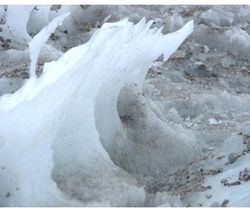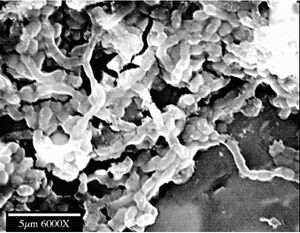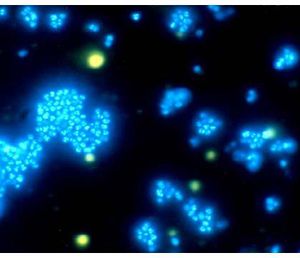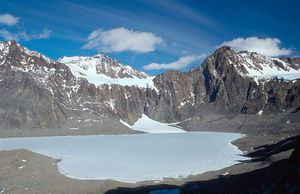Summary of Psychrophilic and Psychrotolerant Microbes found in Polar Expeditions of 1998-2008 by NASA/MSFC/NSSTC Astrobiology group
Introduction
Over the years of 1998-2008, the NASA/MSFC/NSSTC Astrobiology group has performed expeditions to polar environments in order to discover and study psychrophilic and psychrotolerant bacteria to determine the low-temperature limit of life on Earth[2]. Psychrophiles are defined as organisms that can grow only in low temperatures up to a maximum of 20C. Psychrotolerant organisms are like mesophiles (growing at 20-40C), but are able to tolerate lower temperatures albeit with slower growth rates[3]. However, low temperatures are not the only conditions that organisms of polar environments have to endure in order to survive. These polar regions often also coupled with stressful conditions like high/low salinity and pH, anoxic surroundings, as well as increased exposure to UV radiation near the northern and southern poles of Earth[2]. Therefore, discoveries and studies of these psychrophilic and psychrotolerant microbes are pertinent to better understand the possible capabilities of permitting life in harsh polar environments found on Earth, the polar caps of Mars, the icy moons of Jupiter and Saturn, and other extraterrestrial places.
Features of Polar Environments
Novel habitats for microorganisms have steadily been discovered, and continue to be, but the most shocking discoveries have been the result of extremophilic lifestyles, growing in conditions that would otherwise be lethal to most other organisms. These extreme conditions, pertaining to polar environments, would include mostly freezing temperatures and a lack of nutrients.
Permafrost is defined to be soil and/or rock remaining under the freezing temperature of water for at least two consecutive years[5]. One such place with permafrost being investigated is the Permafrost Tunnel in Fox, Alaska, which allows a peek into millions of years of geological history within its multiple layers of strata[8]. A strain of bacterium, Carnobacterium pleistocenium, was found here to be living after thawed from permafrost, suggesting cryopreservation as a method of survival rather than growth[2]. In fact, there have even been cases where bacteria, like Planococcus halocryophilus sp. nov., were reported to be able to grow even in sub-zero conditions of permafrost[11].

“Ice sculptures” are another common polar niche for polar extremophiles studied by the Astrobiology group. Formed due to the repeating summer melting and wind erosion pattern which result in irregularly shaped structures of ice, the formation pattern allowed these ice sculptures to contain debris of rocks and dust. The melting of the ice from sunlight causes water films to form around the trapped debris, creating optimal microenvironments in a frozen, dry environment, resulting in growth[2]. This shows the possibility of microbial life to be found surface layers of ice, like the surface ice of Europa, contrary to previous belief that microbial life could only be reached by drilling beneath the ice surface.
One of the polar environments to house microbial life is Lake Untersee. Located in the Gruber Mountains of central Dronning Maud Land, it is a perennially ice-covered freshwater lake with water pH at ~11 and temperature at ~0.8C[9]. The year-round ice-cover makes Lake Untersee an isolated ecosystem perfect for the study of naturally evolved psychrophiles[9]. The lake was unstratified, supersaturated with diffused oxygen and high alkalinity. However, some stratification was found near the southern end of the lake, containing an anoxic trough in deeper waters coupled with a dramatic decrease in pH[2]. Lake Untersee’s anoxic trough also exhibits the highest methane concentration in any existing ecosystem of Earth, hypothesized to result from the biological production by methanogens[2][10]. The existence of such high methane concentrations in Lake Untersee may offer analogous conditions to those recently observed in polar regions of Mars[2].
Novel Psychrophilic Microorganisms
The following are some important novel bacterium strains discovered from the polar expeditions of 1998-2008. Most of the strains are still unclassified as they were still recently discovered and phylogenetic analysis is not complete.
Carnobacterium pleistocenium FTR1
| Temperature range (C) | pH range | Salinity range (%NaCl) | Metabolism |
|---|---|---|---|
| 0-28C (optimal 24C)[2] | <9.5 (optimal 7)[2] | 0-5% (optimal 0.5%)[2] | Facultative anaerobe, fermentation[2] |
Carnobacterium pleistocenium FTR1 was isolated from permafrost ice samples of Pleistocene Thermokarst Pond of the Cold Regions Research and Engineering Laboratory (CRREL) Permafrost Tunnel in Fox, Alaska[7]. FTR1 was found to have survived despite being frozen for 32,000 years[7]. This extreme case of organism cryopreservation may offer insight into the possibilities of tissue cryopreservation.

Trichococcus patagoniensis PmagG1
| Temperature range (C) | pH range | Salinity range (%NaCl) | Metabolism |
|---|---|---|---|
| -5 to 35C (optimal 28-30C)[2][6] | 6-10 (optimal 8.5)[2][6] | 0-6.5% [2][6] | Facultative anaerobe, sugarlytic fermentation[2][6] |
Strain PmagG1 of Trichococcus patagoniensis was isolated from samples of guano from the Magellanic penguins of a bottom of a tidal pool in Patagonia, Chile. Although not directly found in polar regions of Arctic and Antarctica, this psychrotolerant bacteria was interesting because PmagG1 was found to excrete a capsule of mucopolysaccharide matter under growth at -5C, probably by means of keeping surrounding water in liquid form in order for metabolism to function properly under freezing temperatures[2]. Genome analysis of strain PmagG1 revealed that the 16S rRNA genes for the genus Trichococcus are highly conserved, meaning that the psychrotolerant physiology of the species of Trichochoccus evolved long ago and was tightly conserved within stable chromosomal DNA[2].

Strain ARHSd-7G (genus Salinivibrio?)
| Temperature range (C) | pH range | Salinity range (%NaCl) | Metabolism |
|---|---|---|---|
| 3-40C (optimal 30C)[2] | 5.2-10 (optimal 8.9)[2] | 0.5-24% (optimal 3%) highly halotolerant[2] | Facultative anaerobe, fermentation (sugarlytic preferred)[2] |
Psychrotolerant strain ARHSd-7G was isolated from environmental samples of penguin guano of Spheniscus demersus found only in the South African coast. Although ARHSd-7G is another bacterium not isolated directly from Arctic/Antarctic polar environments, it is of interest because of its highly halotolerant nature coupled with being psychrotolerant. Phylogenetic analysis of ARHSd-7G placed it within the genus Salinivibrio, showing to be closest to S. costicola[2].
Strain ISLP-3 (unclassified)
| Temperature range (C) | pH range | Salinity range (%NaCl) | Metabolism |
|---|---|---|---|
| 0-40C[2] | 6.2-9.8 (optimal 8.5)[2] | 0-1% (optimal 0.1%)[2] | Obligate anaerobe, chemoorganotroph[2] |
Strain ISLP-3 was isolated from an “ice sculpture” found near Lake Podprudnoye in Schirmacher Oasis, Antarctica[2]. The growth-promoting microenvironment of these ice sculptures allow for the formation of a community of microbes including photoautotrophs, like cyanobacteria, and organotrophs, like the novel strain ISLP-3[2]. With communities being able to grow in desolate surfaces of mere ice, microbial life on icy surfaces of extraterrestrial worlds may be possible.
Strains A7AC-96m and A7AC-DS7
| Temperature range (C) | pH range | Salinity range (%NaCl) | Metabolism |
|---|---|---|---|
| ~5-14C[2] | ~7[2] | ~0.5%[2] | Obligate anaerobe, lithoautotroph, homoacetogenesis[2] |
The deep anoxic trough of Lake Untersee provided the highest methane concentration found in any ecosystem on Earth[2][10]. The appearance of such a methane trough is highly contrasted to the oxygen-rich alkaline waters found in the rest of the lake. This highly contrasting stratification is probably due to the lack of water-mixing due to the permanent ice cover which allows Lake Untersee to be undisturbed by wind[10]. As such, oxygen-rich waters would probably be dominated by photoautotrophic cyanobacteria, as shown by the discovery of stromatolites along the lake floor dominated by cyanogenera Leptolyngbya and Phormidium[1]. The methane rich anoxic trough would probably be dominated by methanogens, but no novel methanogens were isolated. Novel psychrophilic homoacetogenic strains (A7AC-96m and A7AC-DS7), however, were instead able to be isolated from the anoxic trough[2]. The homoacetogen predominance may be attributed to homoacetogens having predominant activity over methanogens in lower temperatures[4].
References
[1] Andersen, D.T., Summer, D.Y., Hawes, I., Webster-Brown, J. and McKay, C.P. “Discovery of large conical stromatolites in Lake Untersee, Antarctica.” Geobiology, 2011, 9: 280-293.
[2] Hoover, R.B. and E.V. Pikuta. “Psychrophilic and Psychrotolerant Microbial Extremophiles in Polar Environments.” Polar Microbiol, 2010, 115-116.
[3] Morita, R.Y. “Psychrophilic Bacteria.” Bacteriol Rev, 1975, 39: 144-167.
[4] Nozhevnikova, A.N., Simankova, M.V., Parshina, S.N. and Kotsyurbenko, O.R. “Temperature
characteristics of methanogenic archaea and acetogenic bacteria isolated from cold
environments.” Water Science & Technology 2001, 44: 41-48.
[5] “Permafrost: General Facts.” Permafrost Tunnel Research Facility. 3 January 2012. Cold Regions Research and Engineering Laboratory. 20 November 2012. <http://permafrosttunnel.crrel.usace.army.mil/permafrost/general_facts.html>
[6] Pikuta, E.V., Hoover, R.B., Bej, A.K., Marsic, D., Whitman, W.B., Krader, P.E. and J. Tang. “Trichococcus patagoniensis sp. nov., a facultative anaerobe that grows at -5oC, isolated from penguin guano in Chilean Patagonia.” Int J Syst Evol Microbiol, 2006, 56: 2055-2062.
[7] Pikuta, E.V., Marsic, D., Bej, A.K., Tang, J., Krader,P. and R.B. Hoover. “Carnobacterium pleistocenium sp. nov., a novel psychrotolerant, facultative anaerobe isolated from permafrost of the Fox Tunnel in Alaska.” Int J Syst Evol Microbiol, 2005, 55: 473-479.
[8] Sellman, P.V. “Geology of the USA CRREL Permafrost Tunnel, Fairbanks, Alaska.” U.S. Army CRREL Technical Report, 1967, 199: 1-22.
[9] Townsend, A., Pikuta, E.V., Guisler, M., Stahl, S. and R.B. Hoover. “Anaerobic psychrophiles from Lake Zub and Lake Untersee, Antarctica.” SPIE, 2009, DOI:10.1117/12.828877.
[10] Wand, U., Samarkin, V.A., Nitsche, H.M. and Hubberten, H.W. “Biogeochemistry of methane in the permanently ice-covered Lake Untersee, central Dronning Maud land, East Antarctica.” Limnology and Oceanography, 2006, 51: 1180-1194.
[11] Mykytczuk, N., Wilhelm, R. and Whyte L. “Planococcus halocryophilus sp. nov., an extreme sub-zero species from high Arctic permafrost.” Int J Syst Evol Microbiol, 2012, 62: 1937-1944.

